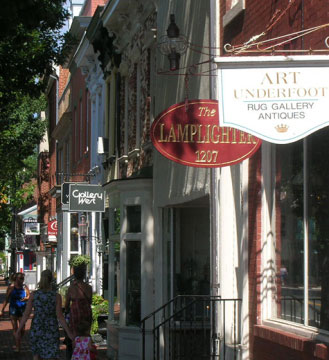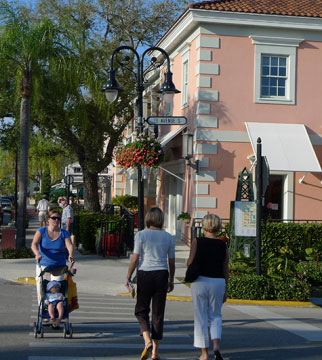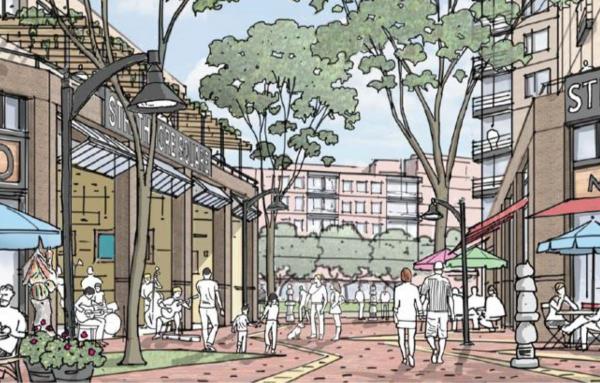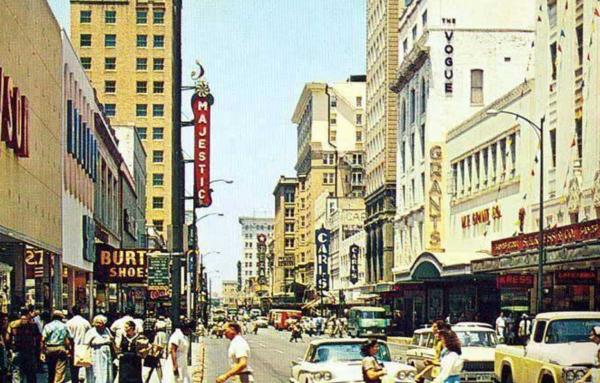After the lockdown, new opportunities for downtown shopping districts
Since the earliest human settlements, the retail experience has evolved to meet the needs of the public. This evolution has taken us from rural markets to towns, cities, suburban shopping malls, big box mega stores, and, more recently, the Internet. But what will retail shopping look like once COVID-19 lockdowns are over and people return to the wild for their shopping experiences?
When all the dust settles, the post-pandemic era should provide a boost to downtown areas, in part due to newly unemployed but highly skilled restaurant and retail workers opening new businesses in downtowns where rent prices will trend downward.
The pandemic has left millions of highly skilled workers from the retail and food and beverage industries unemployed and eager to work. Many of these people are highly motivated to start their own businesses, creating an unparalleled pool of talent and potential entrepreneurial interest.
In a recent Forbes article, Bernhard Schroeder wrote: “27 million working-age Americans, nearly 14 percent, are starting or running new businesses. And Millennials and Gen-Z are driving higher interest in entrepreneurship as 51 percent of the working population now believes that there are actually good opportunities to start companies.”
Traditionally, fear of failure has held people back from starting a business, but with so many having their jobs swept away due to the pandemic, that fear is gone for many people, who realize they no longer want to rely on an employer for the rest of their careers, and instead want to take on the challenge of leading their own companies.
Downtown shopping districts will capture traffic from fading malls
Malls will struggle in the wake of COVID-19. Being inside an enclosed bubble will not be the ideal situation for most shoppers for the foreseeable future. Morning Consult reports that 24 percent of U.S. consumers fear shopping in malls for at least the next six months due to the COVID-19 threat.
As an article about a newly reopened mall in Atlanta explains, the experience won’t be very welcoming in the near term. Play areas are roped off, water fountains covered, and stores are limiting the number of shoppers due to social distancing. Add in the inconvenience factor, and it’s clear why so many malls are facing a reckoning in the coming years.
As regional malls continue losing consumers due to changing shopping habits and fears of COVID-19, an excellent opportunity presents itself for villages, towns, and cities to regain their dominance as thriving centers for retail and entertainment.

Some factors to consider:
- As Millennials and Empty Nesters seek to live, work, and shop in urban centers, medium-sized cities (100,000 to 200,000 population) are especially likely to benefit from this trend.
- Small towns (10,000 to 20,000 people) located near large urban centers are also appealing to start-up retailers and restaurants that want to take advantage of their proximity to large, well-heeled populations and small towns’ affordable commercial storefronts.
- New walkable town centers — planned with authentic urbanism and a variety of hospitality, employment and residential land use — can also ride the wave of Millennials, young families, and Empty Nesters who seek an exciting place to hang out.
Main Streets are already innovating
Main Streets have been reinventing themselves in a positive way during the past few decades, making them a more attractive alternative for retail shopping in the era of COVID-19.
These innovations include:
- Updated master plans that undo blight caused by 1970s urban renewal plans.
- Implementation of Downtown Development Districts, which offer marketing, promotions, special events, street cleaning, landscaping, flowers and private-sector levels of management.
- Effective parking management, and construction of new parking lots and garages.
- Investment in beautiful new streetscapes, public art, and street furnishings.
- Reduction of crime, increased safety.
- U.S. Main Street programs, which offers guidance to revitalize downtowns, and returns $36 for each $1 invested.
For Millennials, who seek more social experiences as opposed to the enclosed mall experience of their youth, Main Street experiences in their towns and cities are the perfect fit for their lifestyle.
While the larger portion of their income will go to experiences such as European travel or outdoor adventures, closer-to-home visits to a local brewpub or coffee shop in their town center make perfect sense.
Main Streets will provide new homes for mall stores
As malls close and online shopping grows, existing mall retailers will seek new locations near their former mall stores. In many instances, these venues include smaller downtown cores, which traditionally offer lower rents and, now, the safety of an open-air shopping experience.
The writing is on the wall for mall store operators, all of which leads to an economically-friendly, Main Street setting:
- Malls depend on department stores to attract almost 50 percent of their shoppers and cannot operate without them, which is problematic for many reasons.
- Many mall retailers have lease options allowing them to break their leases and leave the mall should key department stores close.
- Department stores are losing market share, from a peak of 50 percent of all retail sales in the 1950s to 5 percent today.
- Since the heyday of malls in 1992, department store sales have dropped from $230 billion to $140 billion and many department stores are close to bankruptcy.
- Over 50 percent of regional malls are forecast to close by 2025 (Credit Suisse).

Retail and office space will move to town centers
The online shopping boom has made nearly obsolete many of the conventional large power center retailers offering products such as books, electronics, office supplies, sporting goods, and toys. The end result is the expected closing of millions of square feet of retail space.
Often, these centers cover typically 20-50 acres of prime real estate, which presents an opportunity. They can be converted into mixed-use town centers with medium density residential and commercial occupants.
The same can be said of suburban office parks, as even centers in blue-chip locations are facing high vacancies and declining rents as many major corporations are moving into city centers to attract top talent. Millennials find the suburban office parks boring, preferring to live and work in downtowns. These large office parks have an abundance of land and parking that can be retrofitted into walkable mixed-use town centers.
Downtown shopping districts offer many benefits, including reduced risk of exposure to COVID-19
When a national brand relocates from a mall environment to a town or city, they may initially receive a cold shoulder from city leaders and the community, who fear popular brands will end up killing their beloved Main Street’s unique charm.
Looking back at history, though, this thinking is inaccurate, as downtown shopping districts were filled with leading retailers and large department stores during their 1950s heyday. For long-term sustainability, a downtown should always offer the goods and services desired by its residents and workers, which may include popular brand names.
Zoning is another key battle. Cities must offer flexible form-based zoning to allow for medium-to-high densities of residential and commercial to be developed as walkable neighborhoods and business districts. Development standards should focus on requiring quality design and materials, rather than arbitrary minimal units per acre densities, minimal parking ratios, or suburban building setbacks.
Parking needs to be reconfigured to allow shoppers to pickup goods curbside.
Downtowns and open-air town centers are seen as safer from the pandemic than enclosed malls, as they offer:
- Safer environments.
- Wider spaces.
- Less-enclosed spaces, with more fresh air and direct sunlight.
- The ability to walk on other side of street or block.
- No elevators or escalators.
- Fewer doors to enter.
- Curbside pick-up of goods.
People enjoy visiting towns and cities to socialize and experience parks, urban life, including storefronts. They visit to have an experience they cannot get through online shopping. And while visiting downtowns for entertainment and fun, many will walk by store fronts and be tempted to make impulse purchases from Main Street retailers.
Towns and small city landlords typically offer much cheaper rents than suburban malls, often more than 50 percent less, and also offer flexible lease terms: no minimum hours and less rigorous storefront and merchandising standards than mall leases. This type of accommodation will be more attractive to new entrepreneurs created from this pandemic.
The savings also are appealing to national retailers facing declining sales and mall leases that are too expensive.
How downtown Main Streets can ensure success
As we look to the future, and the economic recovery that will come after the COVID-19 pandemic comes to an end, all signs point to the re-emergence of Main Street as the place people will want to do their retail shopping.
A new generation of entrepreneurs will be eager to start a new chapter in their life, and the suburban shopping centers are not going to attract them.
Well-designed town centers, with the type of social interaction sought by Millennials, young families, and Empty Nesters will be the new home for the post-pandemic boom in the years to come.
A few best practices for downtowns to apply:
- Create a marketing strategy for a post-pandemic campaign.
- Beautify the public realm through landscape, lighting, parking lots-garages, signage, streetscape, and storefront improvements.
- Explore temporary commercial street closures to allow for open air dining and shopping spaces.
- Modify zoning to allow first floor office and service business.
- Require store fronts to maintain large clear glazing, sign bands, operating doors, and ceiling heights to allow for future retail or restaurant use.
- Remove or reduce minimum retail and restaurant parking requirements in downtowns and new mixed-use developments.
- Include generous 10-minute parking spaces to accommodate curbside pickups for restaurants and retailers.
- Devise market-based business recruitment plans and resources to identify and attract new retailers and restaurants into the downtown.
- Seek a balance of local, regional, and national retailers.
- Apply flexible zoning to promote medium-density and high-density multi-family residential.
- Implement market based master plans, form-based codes, and zoning flexibility to allow for retrofitting of underutilized shopping centers and office parks.
This article was published in The Dirt.








